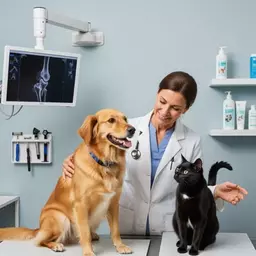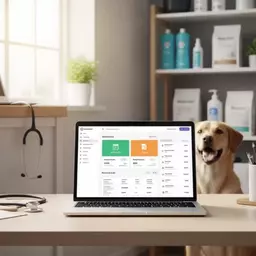In an era where convenience is paramount, the rise of telemedicine in veterinary practices is reshaping how we care for our pets. This innovative approach not only enhances access to veterinary services but also improves the overall experience for pet owners. As we delve into this transformative trend, consider how telemedicine could change your perspective on pet healthcare.
What You Will Learn
- Veterinary telemedicine improves accessibility and convenience for pet owners.
- Understanding the Veterinary-Client-Patient Relationship (VCPR) is essential for effective telehealth services.
- Compliance with local laws and regulations is crucial for successful telemedicine implementation.
- Data security and HIPAA compliance are non-negotiable when handling client information.
- Planning for emergencies and technical failures is necessary to ensure the continuity of care.
- Ongoing education and connection with professional organizations enhance telemedicine practices.
- Staying updated on industry trends allows practices to adapt to evolving client needs.
Key Aspects of Veterinary Telemedicine Implementation
Telemedicine in veterinary practices requires careful consideration of several interconnected factors to ensure successful and compliant operations. The diagram below illustrates the core pillars that veterinarians must address for effective remote care. Staying informed about these aspects is key to understanding veterinary medicine trends for 2025 and beyond.
What is Telemedicine?
Remote consultations, diagnostics, and treatment recommendations using technology for pets. Improves accessibility and convenience.
Legal & Regulatory
- Establish VCPR
- State-specific regulations
- Documentation
Compliance & Data Security
- Client consent & secure storage
- Cybersecurity measures
- HIPAA considerations
Challenges & Contingencies
- Emergency protocols
- Technical failure plans
- Remote monitoring
Next Steps & Support
- Ongoing education
- Professional organizations
- Industry trends
Understanding Telemedicine in Veterinary Practices
In today’s fast-paced world, telemedicine is transforming how we approach veterinary care. As a veterinarian, I’ve seen firsthand how this innovative approach allows for more accessible and efficient healthcare for our pets. But what exactly is veterinary telemedicine, and why does it matter? Let's break it down.
What is Veterinary Telemedicine and Why It Matters
Veterinary telemedicine refers to the use of technology to provide remote consultations, diagnostics, and treatment recommendations for pets. This approach not only helps improve access to veterinary care but also enhances convenience for pet owners. Imagine being able to consult with a veterinarian without leaving your home—this is the future of animal healthcare!
- Convenience for pet owners, reducing travel stress.
- Increased access to specialists, especially in rural areas.
- Timely interventions through remote monitoring.
Moreover, telemedicine can facilitate regular follow-ups and help manage chronic conditions without the need for frequent visits to the clinic. It’s all about making pet care easier and more effective!

Legal Considerations: Navigating the VCPR and Regulatory Landscape
When we talk about veterinary telemedicine, it's essential to navigate the Veterinary-Client-Patient Relationship (VCPR). This legal framework ensures that veterinarians maintain a proper relationship with clients and their pets to provide quality care. Understanding this relationship is crucial for implementing telehealth services effectively. For more details on maintaining pet wellness, consider crafting your pet wellness plan.
- Establishing VCPR before telemedicine consultations.
- Knowing state-specific regulations affecting telemedicine practice.
- Maintaining appropriate documentation for remote services.
By adhering to these guidelines, we can ensure that our telemedicine practices are both compliant and beneficial for our clients and their furry companions.
The Role of Veterinary Regulations in Telemedicine Implementation
Veterinary regulations play a pivotal role in how telemedicine is implemented in practices. Each state may have different rules regarding remote consultations and prescriptions, which can impact the services veterinarians can offer. Staying updated on these regulations is vital for ensuring the safety and legality of our telehealth services.
- Reviewing local laws regularly to stay compliant.
- Engaging with legal professionals to understand telemedicine implications.
- Participating in professional organizations for guidance on best practices.
By keeping abreast of veterinary regulations, we can confidently deliver quality care through telemedicine, enhancing both our practice and the well-being of the pets we serve.
Pro Tip
To enhance your telemedicine services, consider investing in a robust video conferencing platform that is tailored for veterinary practices. Look for features like screen sharing for diagnostic images and built-in appointment scheduling to streamline the consultation process. This can significantly improve the client experience and make remote visits more effective!
Ensuring Compliance and Data Security in Telemedicine
As we embrace telemedicine in veterinary practices, ensuring compliance and data security becomes paramount. Understanding the data privacy and confidentiality requirements is crucial for safeguarding both client information and animal health records. With the rise of digital consultations, veterinarians must stay vigilant about protecting sensitive data and adhering to relevant regulations.
To help you navigate these complexities, I recommend familiarizing yourself with the following key aspects of data privacy:
- Client consent for data collection and sharing
- Secure storage and transmission of veterinary records
- Regular audits of data access and usage
By implementing these practices, you will not only comply with regulations but also build trust with your clients, ensuring they feel secure in sharing their pet's health information.
Implementing Cybersecurity Measures for Telehealth Practices
Cybersecurity is a critical component of any telehealth strategy. As a veterinarian, I take this matter seriously because I want to protect my clients and their pets from potential breaches. Here are some essential cybersecurity measures to consider:
- Utilize encryption for data transmission
- Implement strong password policies
- Train staff on identifying phishing attempts
- Regularly update software and systems to patch vulnerabilities
By proactively addressing these cybersecurity concerns, veterinary practices can mitigate risks and ensure a safe environment for remote consultations.

HIPAA Compliance: Key Considerations for Veterinary Practices
When it comes to telemedicine, HIPAA compliance is non-negotiable. As a veterinarian, I’ve learned the ins and outs of HIPAA regulations to protect pet owners' data. Here are some key considerations to keep in mind:
- Ensure all telemedicine platforms are HIPAA-compliant
- Obtain explicit consent from clients for telehealth services
- Maintain secure communications with clients, using HIPAA-compliant channels
- Develop a breach notification plan
Being diligent about HIPAA compliance not only protects your practice but also demonstrates your commitment to ethical standards in veterinary care. This commitment is similar to the care taken when choosing pet wellness plans wisely.
Preparing for Challenges in Remote Veterinary Care
While telemedicine offers incredible benefits, challenges can arise in remote veterinary care. Being prepared is essential for providing the best service to your clients. Here are some common challenges to anticipate:
- Emergency situations that may require immediate in-person care
- Technical failures that could disrupt consultations
- Limitations in performing physical examinations remotely
By planning for these challenges, you can ensure that you’re ready to tackle any unexpected situations that might arise during remote consultations.
Handling Emergencies Through Telemedicine: Best Practices
Emergency situations can be particularly tricky in telemedicine. To navigate these challenges effectively, consider these best practices:
- Establish clear protocols for recognizing emergencies during consultations
- Provide clients with emergency resources and contact information
- Utilize telemedicine to triage cases effectively and determine if in-person visits are necessary
By adopting these practices, you can enhance your telehealth services while ensuring the safety of your patients.
Contingency Planning for Technical Failures and Service Interruptions
Technical failures can happen, and having a contingency plan is crucial to maintaining a smooth operation. Here are steps you can take:
- Develop protocols for identifying and addressing technical issues quickly
- Provide clients with alternative means of communication during service interruptions
- Conduct regular tests of your telemedicine systems to ensure functionality
Being prepared for technical hiccups will minimize disruptions and keep your clients satisfied.
Remote Monitoring and Diagnostics in Emergency Situations
In emergency situations, remote monitoring and diagnostics can be lifesaving. As a veterinarian, I find it invaluable to use technology to assist in urgent care. Here are some strategies to implement:
- Utilize wearable devices to monitor pets' vital signs in real-time
- Employ mobile apps for pet health tracking and data sharing with clients
- Train staff to interpret data from remote monitoring tools effectively
By leveraging these technologies, you can provide timely and informed care, even from a distance.
Next Steps for Telemedicine Implementation
To successfully implement telemedicine in your practice, it’s vital to focus on ongoing education and support. I often remind my colleagues about the importance of staying informed. Here are some resources you can tap into:
- Online courses focused on telemedicine best practices
- Webinars from veterinary associations
- Networking opportunities within professional communities
By continuing your education, you will stay ahead of the curve and provide the best possible care through telehealth solutions.
Connecting with Professional Organizations for Guidance
Connecting with professional organizations can be incredibly beneficial. They provide a wealth of knowledge and support for veterinary practices looking to expand their telemedicine offerings. Consider reaching out to:
- The American Veterinary Medical Association (AVMA)
- The Veterinary Telemedicine Association (VTA)
- Local veterinary associations with telehealth initiatives
These organizations can offer insights, resources, and a community of professionals who share your commitment to improving animal health. Staying connected is also crucial for understanding 2025 pet wellness trends.
Industry Standards and Trends in Veterinary Telehealth
Finally, staying informed about industry standards and trends is essential for your practice’s success in telemedicine. Here are some current trends to watch:
- Increased adoption of telehealth solutions across the industry
- Emerging technologies that enhance remote veterinary care
- Shifts in client expectations regarding accessibility and convenience
By keeping your finger on the pulse of the industry, you can adapt your practice to meet evolving client needs and elevate the standard of care offered at VetInfo World.
Frequently Asked Questions (FAQs) about Veterinary Telemedicine
What is veterinary telemedicine?
Veterinary telemedicine involves using technology for remote consultations, diagnostics, and treatment recommendations for pets, improving accessibility and convenience for pet owners.
What is the VCPR and why is it important for telemedicine?
VCPR stands for Veterinary-Client-Patient Relationship. It is a legal framework that ensures veterinarians have an established relationship with clients and their pets before providing care, which is crucial for compliant and effective telehealth services.
How do veterinary regulations affect telemedicine?
Veterinary regulations vary by state and dictate what services can be offered remotely, including consultations and prescriptions. Staying updated on these laws is vital for legal and safe telehealth practice.
What are the key data security concerns in veterinary telemedicine?
Key concerns include obtaining client consent for data use, securely storing and transmitting veterinary records, implementing cybersecurity measures like encryption, and ensuring HIPAA compliance to protect sensitive information.
How can veterinarians prepare for emergencies during remote consultations?
Veterinarians should establish clear protocols for recognizing emergencies, provide clients with emergency resources, and use telemedicine to triage cases to determine if an in-person visit is necessary.
Recap of Key Points
Here is a quick recap of the important points discussed in the article:
- Veterinary telemedicine enhances convenience and access to care for pet owners.
- Establishing a Veterinary-Client-Patient Relationship (VCPR) is crucial before consultations.
- Understanding state-specific regulations is essential for compliance in telemedicine practices.
- Data privacy and security measures are vital to protect client information and animal health records.
- Implementing strong cybersecurity practices can mitigate risks associated with telehealth.
- Preparedness for challenges in remote care can enhance service delivery and client satisfaction.
- Ongoing education and connection with professional organizations can provide valuable resources for telemedicine implementation.








